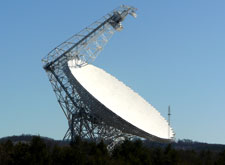- Related Links
- GBT W-band FPA Wiki Page Provides status and links to the W-FPA program
- GBT W-FPA Science Wiki Page Provides links to science cases and listings of important lines
- GBT 4mm Rx Web Page Web page for the GBT 4mm program
- GBT 4mm Rx Wiki Page Provides the status and links to the GBT 4mm program
- GBT 4mm Receiver Project Book Reference material for the 4mm project
Green Bank Telescope W-Band Focal Plane Array Program
Introduction
The combination of high sensitivity, unblocked aperture and wide field-of-view of the Robert C. Byrd Green Bank Telescope (GBT) is well-suited to focal-plane array receivers. Large spectroscopic focal-plane arrays at centimeter and millimeter wavelengths will enable a powerful new set of scientific capabilities with the GBT, both as a stand-alone instrument and in combination with the powerful EVLA and ALMA interferometers. The ability of the GBT to detect low surface brightness emission over wide areas is complementary to the capabilities of interferometers which are sensitive to small-scale structures. With the recent improvements to its surface rms, the GBT is the most sensitive single-dish telescope at Wband (3mm), and with a spatial resolution unmatched by any other single-dish telescope operating at 3mm. Combining this excellent sensitivity and resolution with a large spectroscopic focal plane array would provide unprecedented mapping ability and sensitivity. This will be a uniquely capable instrument for the investigation of the astrochemistry and physical properties and processes associated with molecular clouds and star formation within our Galaxy, nearby galaxies, and objects in the distant Universe.
Key Science
Based on the ASTRO-2010 Survey, four key research areas have been identified for the GBT. The GBT W-band Focal Plane Array (W-FPA) would greatly enhance the science capabilities in all of these areas:
- Fundamental Physics -- The GBT W-FPA will enable studies of fundamental chemistry of molecular species under the physical conditions and time scales not achievable in terrestrial laboratories.
- Origin of Life -- The GBT W-FPA will carry out molecular spectroscopy of complex organic molecules and pre-biotic molecules in the ISM and comets which are key for studying the conditions from which life eventually forms.
- The Context of Star Formation -- The GBT W-FPA will provide efficient wide-area mapping of star-forming regions of many important molecular transitions which is key for understanding the dependencies between the large-scale processes within the ISM and the formation cold proto-stellar cores from which stars form.
- Galaxies Across Cosmic Time -- The GBT W-FPA will provide mapping studies of CO and the dense gas tracers, such as HCN and HCO+, of significant samples of nearby galaxies, as well as for the measurements galaxies and clusters in CO(1-0) at intermediate redshifts which is a key cosmological period over which galaxies evolve.
Status
Front-end design considerations are underway. The near-term plan (~2yrs 2011-2012) is to design and build a prototype system (e.g., one blade or two of order 8 elements) which could be scaled to the full ~100 element system without significant additional R&D. The prototype system would be made compatible with the GBT spectrometer and the current transmission system and limited to 16 single polarization elements. The data transmission system and spectrometer would require significant upgrades for the full ~100 element system.Specification Summary
The system will be designed for spectroscopy, although basic continuum observations will be supported for pointing and focus. Continuum science will be done primarily with Mustang. VLBA observations will not be supported with the W-FPA; VLBA can be done with the planned 4mm system. The goal is to potentially cover the entire 3mm atmospheric window (~67--116 GHz), but ALMA Band-3 is the priority with optimization of the instrument at around 90 GHz.- Frequency range: 84--115.3 GHz. Matches ALMA Band-3 and reaches the 12CO(1-0) transition at the high-frequency end of the band. Coverage at lower frequencies would be beneficial, if possible (~67--115.3 GHz).
- Receiver temperature: <~60 K from 86 -- 94 GHz and <~80 K outside the central band.
- Array footprint: 2--5 arcmin.
- Feed separation: <~30 arcsec.
- Number of feeds:>= 8, but the system should be scalable up to of order 100 elements.
- Single linear polarization per feed.
- Instantaneous Bandwidth: >=1 GHz per feed.
- Optical Isolation (between beams): >~15 dB
- Electronic Isolation: >25 dB
- Relative calibration between elements reproducible to better than 5%.
- Supported observing modes:
- Spectroscopy with the standard spectrometer setups
- Position switching
- Frequency switching
- SubBeamNod
- On-the-fly mapping
- Total power detection with the DCR
- Spectroscopy with the standard spectrometer setups



